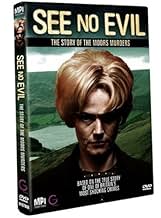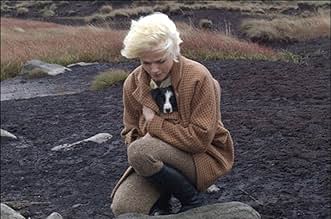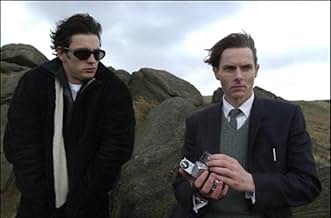See No Evil: The Moors Murders
- टीवी मिनी सीरीज़
- 2006
- 1 घं 9 मि
एक जीवंत नाटक जो कुख्यात मूर्स हत्यारों; इयान ब्रैडी और मायरा हिंडले के बारे में बताता है.एक जीवंत नाटक जो कुख्यात मूर्स हत्यारों; इयान ब्रैडी और मायरा हिंडले के बारे में बताता है.एक जीवंत नाटक जो कुख्यात मूर्स हत्यारों; इयान ब्रैडी और मायरा हिंडले के बारे में बताता है.
- 1 BAFTA अवार्ड जीते गए
- कुल 4 जीत
फ़ीचर्ड समीक्षाएं
It reminds you this can happen anywhere and be anyone you know. The show has great attention to detail and 1960s Working class England is brought to life amazingly well. You feel like you are actually there. The houses and streets are grim and so are the people and their life's: Teenagers married with babies, young men struck on the dole, violent men ignored and semi accepted by everyone. It doesn't strike me as a time of innocence shattered by the Moor Murders but a time full of narrow-mindedness with a simmering undercurrent of brutality.
The cast all play their roles fantastically and the script is excellent. No character is completely sympathetic and no character (with the exception of Brady) is one dimensional . Even Hindley, in a controversial move is portrayed as someone who loves her sister fiercely and is capable of compassion for her niece and dogs. All in all, an excellent sensitive, realistic portrayal of the banality of evil and the extraordinary aspects of normality .
To mark the 40th anniversary of Ian Brady and Myra Hindley's convictions for the horrific 'Moors Murders', ITV1 has produced this dramatization of their hunt, capture and conviction, charting their friendship with Dave Smith (Michael McNulty), boyfriend of Hindley's sister, whom Brady tried to warp into his twisted little world. It was only when he saw Brady butchering 17 year old Edward Evans to death that it all came out and the pair were caught.
People reacted to this production with the expected mixed emotions. It was always going to be one of the most controversial productions the station had ever green-lighted, and there was understandable out-rage, offense and shock from some when it went ahead. But the families of the victims were okay with it and this drama does manage to be as realistic yet sensitive as it could possibly be.
This can hardly be described as 'entertaining', but by telling the dark true story that it is, it does play out with the required haunting gusto, with some dark camera shots and a few quiet, reflective scenes.
Performances wise, Sean Harris and Maxine Peake as the two main characters are highly effective, as are some of the supporting cast including George Costigan as the detective who lead the investigation that brought the pair to justice. Some of the others might need to brush up on their craft a bit, but they do not stop what is generally a well made and very effective timely re-telling of events nobody wanted to know but had to hear. ****
The one large problem with the production is with the story being so unremittingly harrowing and unpleasant,one is somewhat confused as to what to say in conclusion.That it is very well made,acted and produced,certainly.That we do not see the killings themselves(with the savage exception of Edward Evans,very brutal and in semi-darkness),and none of the gruesome details related to them is praiseworthy;but the extreme nastiness surrounding the whole case still makes for a very dubious and disturbing cumulative effort despite it's considerable technical quality.In my view,a more documentary approach to the subject would've been the correct way to dramatise such a story,but nevertheless full marks to cast and crew for their sensitivity in handling such a dreadfully grim subject.
While I was watching I was struck by all of the things that weren't or couldn't be shown in the film (such as the kidnappings of the children and the disposal of their bodies on the moors, as well as the infamous photographs and tape recording of Lesley Ann Downey's torture and murder). These omissions tend to throw the viewer off a bit since there is barely anything that suggests the killers' motivations. Too many important facts and details are mentioned in the past tense, and not enough is dramatized and shown as happening in the present moment -- this circuitous approach tends to blunt the impact of the story as a whole.
As the psychopath Ian Brady, Sean Harris is a fine actor with an interesting, enigmatic presence, and his performance is more or less adequate. But strangely, he doesn't seem to project enough menace in the role. He scowls and looks pale and ghastly and speaks in a soft-spoken Scots accent -- which, to my ears, sounds a little forced and put-on. For the most part (and the limitations of the script may be partly to blame for this), he comes across as an actor merely playing at being a psychopath, rather than a man genuinely unhinged -- someone who feels compelled to commit senseless, heinous acts of violence. He is at his most convincing (and scary) when he sees that Dave Smith (Michael McNulty) has given him up to the police, and he flashes his young friend a condescending smirk. Harris is also quite believable when he has a battle of wits with George Costigan, who plays police DCI, Joe Mounsey -- giving defiant, insolent non-answers to the detective's incisive, probing questions.
As the notorious Myra Hindley, Maxine Peake probably delivers the best performance, but the script seems to undermine and shortchange her character. We never really learn very much about her -- such as what her life was like before she met Ian Brady and what attracted her to him, what the dynamic of their relationship was, as well as how her personality changed as a result. We certainly don't learn anything about why she participated in the sadistic murder of young children. The movie also makes the mistake of trying to replicate Myra's infamous 1965 mug shot and it only serves to emphasize that, apart from the clothes and the hair, Maxine Peake really doesn't look that much like the actual person she's portraying.
As David Smith, Michael McNulty does indeed look a great deal like the actual person he is meant to be. Although, I got a sense that the writer sanded the rough edges off his character a bit too much -- especially Smith's putative alcoholism and spousal abuse -- in order to make him more palatable and sympathetic to the audience.
Joanne Frogatt plays Maureen Hindley, Myra's kid sister and Dave Smith's shotgun bride, and the film takes her point of view. While the filmmakers were clearly trying to preserve a little taste by maintaining a slight distance from the two killers and their crimes, adopting Maureen's perspective (especially as played by Frogatt) seems a mistake. Indeed, it turns out to be a rather unrevealing vantage point that yields precious little insight about events.
Not surprisingly, Frogatt's Maureen turns out to be the sole straight arrow amidst this otherwise unsavory quartet, and the movie seems partly intended as a rehabilitation of both her and David Smith's public image in connection with the murders. Unfortunately, Frogatt is as dull as ditchwater in the role, and with her pasty, angular, dark-haired features and de rigueur beehive hairdo, Frogatt looks like she could be one of Sean Harris' siblings rather than Maxine Peake's. By the end of the movie, despite all of my prior knowledge about the case, I was left feeling just as bewildered and in the dark about everything as Maureen did. With Frogatt's character as the story's center of gravity, the moral sense of the movie seems rather uncertain and hesitant and vaguely apologetic. An earnest, token effort is also made to show the suffering of the relatives of the victims, so as not to run the risk of inadvertently valorizing the two killers. These people -- in particular, the actors playing John Kilbride's father and Lesley Ann Downey's mother -- often come across more vividly than the two criminals and their close relations do. This aspect of the movie focuses on the efforts of Detective Mounsey and as such, "See No Evil" awkwardly tries to tell two converging stories from two different outside points of view at the same time.
In the end, I just didn't feel that this production really did justice to the Moors Murders (pardon the pun). The only time that the grisliness and horror of the killings are really felt is when the police search team digging on Saddleworth Moor retrieves Lesley Ann Downey's body from her grave in the middle of a foggy night. A story like this demands a more detailed narrative context and a stronger viewpoint (even if this necessitates a bit of speculation and guesswork) or it risks wishy-washy banality. This subject would be served by a proper feature film treatment, even though the serial murder genre has practically been done to death in the movies (again, pardon the pun).
क्या आपको पता है
- ट्रिवियाThe photos shown of the missing children are those of the real victims.
- गूफ़The police use Maglite® torches which did not exist until 1979.
- भाव
[talking about Myra, several years after her conviction and imprisonment]
Maureen Smith: I have to believe what my heart tells me, Dave. And my heart tells me whatever Myra did in the past, she's a different person now.
Dave Smith: She's worse than Brady, Maureen. I mean, he's just a sicko, a sex case - the king of the sex cases. But Myra - she's human: she had feelings. Remember the tears when Angela Dawn died? That card she gave us? "Another little flower for God's fucking garden"! Jesus! She was killing kids at the same time.
Maureen Smith: All right. All right. You believe what you want to - but please, please, can't you let me do the same?
Dave Smith: Of course. Sorry, Maureen.
Maureen Smith: If we can't put it behind us...
Dave Smith: We've got to, for the kids' sake. We can do it, girl.
टॉप पसंद
- How many seasons does See No Evil: The Moors Murders have?Alexa द्वारा संचालित
विवरण
इस पेज में योगदान दें




























